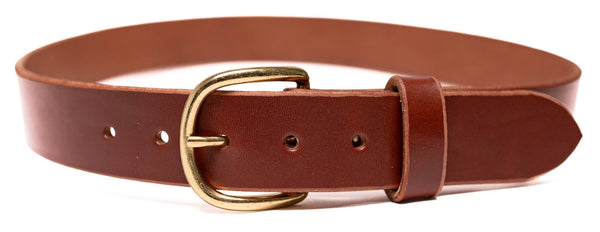Vegetable Tanning vs. Chrome Tanning: Which Leather is More Durable For Work Belts
Apr 29, 2025
Why Leather Tanning Methods Matter for Your Work Belt
Leather tanning makes a big difference in how your leather gear holds up over time.
Whether it's a full-grain leather work belt, wallet, or boots, the tanning method affects the look, feel, and durability of the leather.
This article breaks down the two main tanning methods: vegetable tanning and chrome tanning.
It’ll show you why vegetable-tanned leather is the better choice for work belts.

The Two Main Leather Tanning Methods
Leather tanning is what turns raw animal hides into leather. There are two main ways to tan leather: vegetable tanning and chrome tanning.
Let’s break them down:
- Vegetable Tanning: This method uses tannins from plants like oak, chestnut, and hemlock. It takes a long time, sometimes weeks, for the tannins to soak into the leather. Over time, this leather gets better, developing a rich, unique look called a patina.
- Chrome Tanning: A quicker method that uses chromium salts and chemicals, making it a faster process (just a few days). The leather looks consistent, but it doesn’t age well or develop the same character as vegetable-tanned leather.
Vegetable Tanning: The Natural Way
Vegetable tanning is one of the oldest methods around, dating back to ancient Egypt, Rome, and Native American times. The history of vegetable-tanned leather is very rich.
The process involves soaking leather in natural plant solutions, which takes weeks. This slow process makes the leather strong and flexible. Over time, it develops a unique darkened look, adding character as it ages.
The best part? It’s sustainable. The tannins come from trees and plants, making vegetable-tanned leather an eco-friendly choice.
Chrome Tanning: Fast But Short-Lived
Chrome tanning is a newer method that came along in the 1800s. It uses chemicals to speed up the process. In just a few days, the leather is ready to go.
But while it’s quicker and cheaper to produce, chrome-tanned leather doesn’t have the same backbone. On a belt, it’s more likely to stretch out, lose its shape, and start looking tired way before a vegetable-tanned belt would.
The Science Behind Leather Tanning
The difference between vegetable-tanned and chrome-tanned leather comes down to the chemical process.
Vegetable-tanned leather has tannins that bind to the leather’s fibers, making it stronger and more flexible. Over time, it softens and becomes more comfortable to wear. Chrome-tanned leather is softer at first, but doesn't age the same as vegetable-tanned leather
Vegetable-tanned leather is also more breathable, which is why it's so comfortable for daily wear, whether it's a belt or boots.

Environmental Impact: Natural vs. Chemical-Heavy
Vegetable tanning is known for being good for the environment. The plant-based tannins are biodegradable. That just means that the leather breaks down without harming the environment.
Chrome tanning uses chemicals like chromium salts, which can pollute water and soil, and can be a risk to human health. Despite being cheaper and faster, chrome tanning is much worse for the environment.
Which Leather Is Best for Your Gear?
- Belts: For work belts, vegetable-tanned leather is the gold standard. It’s sturdy, resists stretching, and molds to your waist over time for a fit that gets better with every wear. Chrome-tanned belts, while cheaper, are more prone to sagging and don’t hold up as well under daily strain.
- Wallets: Both vegetable-tanned and chrome-tanned leather can work here. If you want something that breaks in beautifully and lasts for years, vegetable-tanned is a solid investment. But if you’re on a budget, chrome-tanned wallets are more affordable and still look great.
- Boots: Tough jobs demand tough leather. Vegetable-tanned leather holds up better in rough conditions and resists cracking and wear. It’s stiffer at first but softens with use, forming to your foot. Chrome-tanned boots can be more comfortable right away, but they tend to wear out faster under heavy use.
- Other Products (Bags, Keychains, etc.): This is where chrome-tanned leather shines. It’s softer, lighter, and more flexible. It’s great for bags, accessories, and everyday carry items. It’s also easier to dye, which means more color options at a lower price.
The Final Verdict, Why Vegetable-Tanned Leather Wins
Chrome tanning is faster and cheaper. But vegetable tanning is the way to go for durability, comfort, and long-lasting leather.
The slow, natural process results in leather that not only looks better over time but also stands up to the toughest conditions. If you want leather that’ll hold up and get better with age, vegetable-tanned leather is the choice.
At Proven Hands, we use vegetable-tanned leather for our full-grain leather work belts. We source from Wickett & Craig, one of the oldest American Tanneries that do it the right way. Crafted with care, these belts are built to last. And each one is handmade and 100% made in the USA.
Proven Hands’ Commitment to Vegetable-Tanned Leather
At Proven Hands, we’re all about quality. Our full-grain leather work belts are made from vegetable-tanned leather, crafted by hand to last you for a lifetime.
If you're searching for a durable work belt that can handle the same hard work you do, you've found it.
Limited Supplies - Don't Wait Long to order your work belt!
If you want a strong full-grain leather work belt, made with vegetable tanned leather, then choose Proven Hands.
There are 3 Proven Hands Full-Grain Leather Work Belts to choose from.
The Classic Belt
Best for: Everyday wear, light-duty work, or casual conceal carry
The Settler Belt
Best for: Heavy-duty use, workwear, or strong conceal carry support
The Pioneer Belt
Best for: Maximum durability, moisture resistance, or frequent heavy load
Follow us on Instagram or join our newsletter for updates and discounts that save you money.







